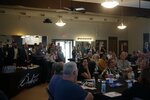On Oct. 9 in the Croatian Hall in South St. Paul, Dakota County held its annual State of the County event. The event, attended by mayors, legislators, school board members and residents of the …
This item is available in full to subscribers.
To continue reading, you will need to either log in, using the login form, below, or purchase a new subscription.
If you are a current print subscriber, you can set up a free website account and connect your subscription to it by clicking here.
Otherwise, click here to view your options for subscribing.
Please log in to continue |



On Oct. 9 in the Croatian Hall in South St. Paul, Dakota County held its annual State of the County event. The event, attended by mayors, legislators, school board members and residents of the county, showcased all that has been done throughout the year, what the county is working on, what it has accomplished, and where it is going.
At the event, Commissioner Joe Atkins walked through some of the functions overseen by the county: “We provide public safety and operate Dakota 911. We run the jail, prosecute all the felonies county-wide. We handle 50,000 crisis intake calls a year and maintain 1,050 lane miles of county roads and 164 bridges. We also operate 10 libraries that welcome 2 million visitors who checked out 4 million materials last year.”
It was a chance for the county to run through recent accomplishments like the near-completion of greenways including the 28-mile Mississippi Greenway, the return of Bison to the county, and the completion of infrastructure projects like the opening of Kaposia library and the upgrades to Lake Byllesby Dam.
During the speech, Atkins highlighted the utility of the county’s drone team, a specialty unit of 15 deputies trained to operate unmanned aircraft systems.
“The ability to safely view potentially dangerous situations is bringing more critical incidents toa safe and peaceful end,” said Atkins.
Sergent Sean Qualy, a member of the drone team flew one of the county’s drones through the open door of the hall and around the room, livestreaming footage from the drone’s camera of the inside of the hall to the crowd.
Only after the drone had successfully flown back out the door did Atkins take a sigh of relief. “Oh my God, I’m so glad that went right.”
2024 is the 175th anniversary of the founding of Dakota County, one of the original nine counties of then-territory, created by the Minnesota Territorial Legislature in 1849. Minnesota would not join the union until nearly a decade later in 1858. The walls of the Croatian Hall were lined with signs detailing the history of Dakota County both before European settlers arrived and afterward.
That history was recognized both in a presentation of officers lost in the line of duty dating back into the 19th century as well as in recent work done in concert with state and federal legislators.
“Across no time in Dakota County’s 175-year history have our partners at the state and federal level delivered more for Dakota County than in the last five years,” said Atkins.
Sen. Jim Carlson (52, DFL), Rep. Liz Reyer, (52A, DFL) Rep. Mary Francis Clardy, (53A, DFL) and Rep. Jessica Hanson (55A, DFL) were all recognized while attending the event. Atkins also referenced the county’s national legislators: Rep. Angie Craig, (D-Minn), Sen. Amy Klobuchar (D-Minn), and Sen. Tina Smith (D-Minn). Atkins referenced various projects throughout the county including the upgrades to Lake Byllesby Dam, the construction of Kaposia library, as well as future upgrades to Croatian Hall itself.
After the event, the county held a political panel to discuss the state of the election both in Minnesota and in races across the country. The panel was moderated by Amber Backhaus, vice president of government relations for United Strategies, and consisted of Dan Dwight, director of government affairs at Stinson LLP; Elizabeth Emerson, vice president of public relations-advocacy firm Goff Public; and John Reich, a senior principal with public affairs firm Cozen O’Conner.
The panel answered questions and made predictions regarding if the DFL will maintain its control over the entirety of Minnesota state government. The creation of a future bonding bill in the next legislative session, as well as the outcome of the US Presidential Election.
As to the DFL maintaining its control over the House of Representatives, Senate and Governorship, Reich expressed doubt that the DFL would maintain its trifecta, but said much of the momentum depended on excitement of up-ticket races trickling down to local races, citing excitement about Trump being able to energize voters for local Republican candidates. Emerson said she expected the DFL to maintain its trifecta were the election to be held today, while Dwight echoed the importance of up-ticket races.
A bonding bill in the upcoming legislative session is a topic of particular significance to Hastings as an avenue for potentially paying for future water treatment plants in the city. Last year talks of a bonding bill fell apart, and this year—a budget year in the Minnesota congress—eyes far beyond Hastings will be on the capitol watching to see what, if any, funds come from it via a potential bonding bill.
Reich expressed skepticism over a potential bonding bill next year. He cited the strained relationships at the capitol due to the DFL’s total control of congress and ability to not have to work with their Republican contemporaries. Emerson agreed that she didn’t think there would be a bonding bill next year, but instead cited the high number of freshman lawmakers who will be going to St. Paul for the next session. Dwight disagreed saying he expected a bonding bill, but one far smaller than previous massive bonding bills.
Finally, the panel weighted in on their thoughts about the question being felt around the county and around the world: who will win the 2024 US Presidential Election. The panelists all agreed that they believed Kamala Harris would win the election but expressed doubt that Democrats would hold onto a majority in either the House of Representatives or the Senate.